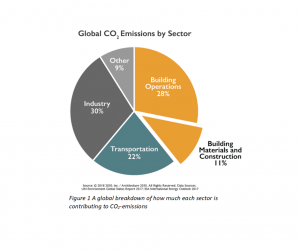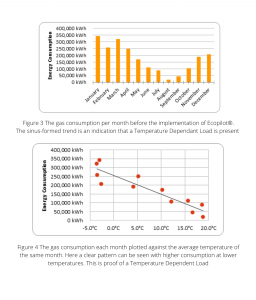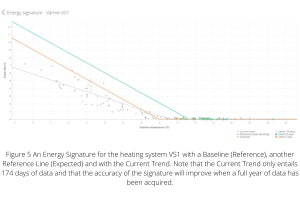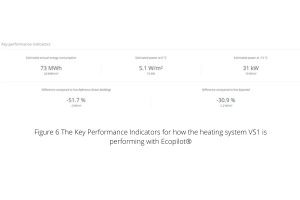MEASUREMENT & VERIFICATION IN ECOPILOT®

In all projects including Energy Conservation Measurements (ECM) it’s important to be able verify the savings. This is done through Measurement & Verification (M&V) where the International Performance Measurement and Verification Protocol (IPMVP) have defined one of the most widely followed best practices in the field.
The strive to combat climate change and to meet the goals of the Paris climate agreement have put energy efficiency higher and higher on the agenda for many companies and government agencies across the world. In the western countries, buildings and their associated energy consumption make up about 40% of all greenhouse gas emissions which means that their improvement is going to play an important role in meeting these goals.
 With increased energy prices,
transmission costs and taxes comes a financial incentive to do this and it’s not uncommon that companies can
save 20-40% of their HVAC’s energy consumption through the implementation of modern equipment and smarter
control strategies with Ecopilot®.
With increased energy prices,
transmission costs and taxes comes a financial incentive to do this and it’s not uncommon that companies can
save 20-40% of their HVAC’s energy consumption through the implementation of modern equipment and smarter
control strategies with Ecopilot®.
A common way to make such improvements are through Performance-Based Contracts where a company promises to deliver at least a certain amount of savings either with an up-front cost or with the company charging what they’ve saved for a fixed number of years. Such an approach can minimize the risks for the building owner or building management company, but also requires a well thought out method for Measurement & Verification of energy savings that both parties can agree upon. Here we describe Measurement & Verification in general and how Ecopilot® is following the established industry-standard.
The U.S. Department of Energy’s Federal Energy Management Program’s (FEMP) guidelines for measurement and verification describe four different Options (A-D) of determining the energy savings from energy efficient equipment, water conservation, improved operation and maintenance, renewable energy, and cogeneration projects. These Options have previously been defined as best practices by the International Performance Measurement and Verification Protocol (IPMVP) and are widely recognized by different government agencies across the world. While IPMVP have defined a number of options that should be used for Measurement & Verification, they have not made a step by step instruction of how the actual process should be carried out. This decision still remains in the hands of the energy auditor as IPMVP recognize that each project will have its’ own possibilities and challenges.
The Options described by IPMVP as best practice are:
- Partially Measured
- Retrofit Isolation
- Whole Facility
- Calibrated Simulation
The different Options are explained in Table 1 below:
| IPMVP Option | Supported by Ecopilot® |
| A. The energy performance of the system to which ECM was applied is measured over a shorter period of time, usually using temporary measurement devices. The results are then extrapolated to calculate what the annual energy consumption of the component should be. This approach is most commonly used for smaller components such as pumps and fans. |
No |
| B. Here the energy performance of the system to which ECM was applied is measured over a longer period of time or continuously. This Option is usually more expensive but has become more readily available over the last few years due to sub metering becoming a standard in new installations and because more expensive pressure modulated pumps and EC-fans may have integrated energy meters that can be connected to the Building Management System (BMS) |
Yes |
| C. Here the energy usage is measured for the whole facility. The easiest way of doing this is by looking at the bills for gas, district heating, water and electricity but most modern meters also have the ability to report its’ consumption in real time through an interface like Modbus, BACnet, M-bus, pulse, etc. By comparing the energy usage before and after the ECM, one can see how the change has affected the overall consumption of the media. This Option is best used when major refurbishments have been done, such as the installation of a new boiler or when the control strategy for the building is being changed |
Yes |
| D. A calibrated simulation means that no actual measurements are made on components or the building itself. Instead a simulation model is created which is supposed to show how the component, system or building would behave during a normal year. This is then compared to the pre-ECM behavior to estimate what the savings should be like. This approach is best used for simple applications such as when ordinary lights are changed to LED. In cases like this, the energy savings can be easily derived from the difference in specifications. For larger application this approach usually requires substantial knowledge about computer modeling as well as specialized software to run the simulations. |
No |
Ecopilot® connects to all of the available main- and sub-meters in a building to gather its’ energy
data. The data can be gathered from any source that supports BACNet,
Modbus or JSON-RPC which means that the source
could be both a BMS, a gateway or the meter itself. All of this means that Ecopilot® is
compliant with IPMVP’s standards for both
Option B and Option C when it comes to
Measurement & Verification.
Energy Signature – The most reliable way to do normal year correction of energy data
Ecopilot® uses the Energy Signature method for normalization and verification of savings which has several
advantages over other common methods such as Degree Day Compensation.
CIT Energy Management AB
have compared different methods of normalizing energy data and they found that the Energy Signature gave the most
accurate monthly compensation over a range of building types and weather conditions. Their study is backed by another
paper published by
The Swedish Energy Agency. Together
they’ve identified the following advantages with the Energy Signature method:
- The Energy Signature method can be used with any building regardless of its’ balance point temperature. Degree Days are usually generated for a model building with a high balance point temperature and the more the model differs from the actual building, the more error you’re going to get when you normalize your energy data.
- The Energy Signature method uses the local weather for its’ calculations which may differ significantly from the nearest weather station, especially in crowded cities.
- The Energy Signature method allows you to compare buildings that are situated in different cities or even countries, regardless of what the annual average temperature is on site. This means that you can objectively compare buildings to one another to determine which has the best fabric or system setup. An example of how the temperature may differ in different parts of a country can be seen in Figure 2.
More and more professionals are starting to use the Energy Signature method and it is used by both energy consultants, researchers, government agencies and energy companies for normal-year correction of energy data and load prediction.
Below is a description of the methodology used by Ecopilot® in creating an Energy Signature for measurement and verification.
 Acquiring Baseline Data
Acquiring Baseline Data
To create the baseline of a building or a system in an Ecopilot® project, monthly non normalized energy data
from a reference year is required. Data from logs in the BMS or other 3rd
party system as well as CSV- or other data-files, monthly bills etc. can all be used for this. The data is preferred
to be based on calendar months but if there are overlaps it can still be used with the help of analysis software and
extrapolation techniques.
Determining and normalizing the Baseline
The next step in the process is to determine whether the measured systems have a
Temperature Dependent Load or not. This is done by analyzing the energy consumption data
looking for differences in consumption based on time of year and average temperatures. An example of what that may
look like is shown in Figure 3 and Figure 4
.
Next, the Base Load and the Temperature Dependent Load are calculated using the reference year’s average temperature and entered to form a baseline of comparison in the Energy Signature. By entering the normal annual average temperature for the location as recorded by the country’s national weather institute this baseline is now corrected to reflect the energy consumption as it would be in a normal year.
Calibration of the Energy Signature
When we have a full month of readings from an outdoor temperature sensor that is unaffected by sunshine, we can
compare that sensor’s average reading to the closest official weather station to compensate for the
micro-climate that this specific building is experiencing.
Adding additional Reference Lines
 With Ecopilot® controlling the building we expect a
significant reduction in energy usage. In the heating case however, the Base Load
won’t change, nor will the buildings’ thermal performance (it’s
Temperature Dependent Load) so what we will affect with Ecopilot® is the
building’s Balance Point Temperature, meaning in this case the outdoor temperature
when the heating system needs to turn on. By using a smarter control strategy and by using the available free heat
that we get from internal loads and sunny weather we can delay when we need to turn the heating system on, thus saving
energy. Our savings estimates are experience based and by trying new
Balance Point Temperatures we will eventually end up with another reference line that
represents the savings that we expect to see. This is something that can be added to the Energy Signature as an
additional reference line (see Figure 3). Other things that one might want to visualize are
future energy goals for the building and past outcomes at the end of each year. Since Ecopilot® doesn’t have
any restrictions of how many reference lines you can have, the Energy Signature can easily be modified to give you the
statistics that you’re looking for right now.
With Ecopilot® controlling the building we expect a
significant reduction in energy usage. In the heating case however, the Base Load
won’t change, nor will the buildings’ thermal performance (it’s
Temperature Dependent Load) so what we will affect with Ecopilot® is the
building’s Balance Point Temperature, meaning in this case the outdoor temperature
when the heating system needs to turn on. By using a smarter control strategy and by using the available free heat
that we get from internal loads and sunny weather we can delay when we need to turn the heating system on, thus saving
energy. Our savings estimates are experience based and by trying new
Balance Point Temperatures we will eventually end up with another reference line that
represents the savings that we expect to see. This is something that can be added to the Energy Signature as an
additional reference line (see Figure 3). Other things that one might want to visualize are
future energy goals for the building and past outcomes at the end of each year. Since Ecopilot® doesn’t have
any restrictions of how many reference lines you can have, the Energy Signature can easily be modified to give you the
statistics that you’re looking for right now.
Comparing the buildings’ current performance to the Reference Lines
 At the end of each day we will plot the daily mean specific
power usage together with these reference lines and in time we will end up with an energy pattern of our own, namely
the Current Trend which can also be seen in
Figure 3. By comparing this trendline to our reference lines we can easily determine how large the savings
are. This information together with some other calculated performance indicators make up our
Key Performance Indicators seen in Figure 4. All of these
indicators are relevant when comparing different buildings to one another and together they give you a good
understanding of how well the buildings are performing. The actual energy usage is also saved in tables for future
reference or for analysis by a 3rd party.
At the end of each day we will plot the daily mean specific
power usage together with these reference lines and in time we will end up with an energy pattern of our own, namely
the Current Trend which can also be seen in
Figure 3. By comparing this trendline to our reference lines we can easily determine how large the savings
are. This information together with some other calculated performance indicators make up our
Key Performance Indicators seen in Figure 4. All of these
indicators are relevant when comparing different buildings to one another and together they give you a good
understanding of how well the buildings are performing. The actual energy usage is also saved in tables for future
reference or for analysis by a 3rd party.
Conclusion
Ecopilot® complies with IPMVP’s Option B
and Option C regarding
Measurement & Verification. The Ecopilot® software uses the
Energy Signature method to normalize energy data and to calculate the achieved energy
savings. The benefits of the Energy Signature method are that accurate
savings and load estimate calculations can be made for buildings with different balance point temperatures situated in
different climate zones while considerations are made to every building’s unique micro-climate.